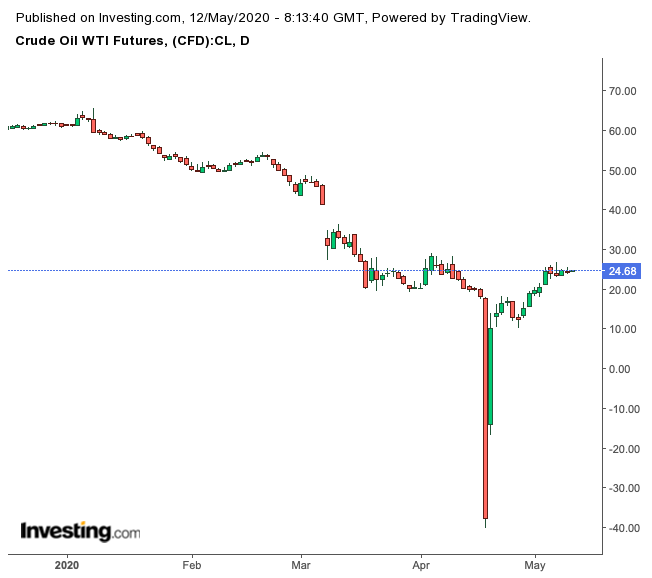It’s certainly not the swinging days of the “Drill baby, drill!” phenomenon. Yet, U.S. crude production is creeping up—rising slowly but surely with the price rebound of the past two weeks.
And that’s the worst possible thing that could happen for the long-term health of the shale industry.
Prolonged and severe price crashes aren’t new to oil. But never before have they involved a double-whammy of simultaneous supply and demand shocks that have brutalized the market to the extent we’ve seen.
The pandemic-forced lockdowns of the past two months have not only erased nearly a decade’s worth of oil demand. They’ve upended markets in disparate ways, with regional dislocations and uneven demand destruction across products paving the way for a messy, disjointed recovery, New York-based Energy Intelligence observed in a blog issued last week.
Day By Day Responses Needed
Royal Dutch Shell (NYSE:RDSa) CEO Ben van Beurden has also noted that the present dynamics in oil involve “a level of uncertainty that you cannot model with scenarios” and supply and trading responses need to be taken “day by day.”
Therein comes the debate about the price recovery we’re in. Barring Monday’s relatively modest decline of under 2.5%, U.S. crude’s U.S. West Texas Intermediate benchmark has seen phenomenal gains lately: 25% last week; 17% the previous week; and a total of 100% from the lows of 11 days ago. And production is rising as a result.

Shut-in wells In the Permian Basin’s Midland region have started reopening, Mackie McCrea, chief commercial officer at pipeline giant Energy Transfer (NYSE:ET), told a conference call on Monday.
"About 8% of oil volumes that fed Energy Transfer’s pipe network in the Midland had been shut at the start of the month," Bloomberg reported. As of the start of this week, some 25% of that was back, McCrea said.
Some U.S. Drillers Seem Ready To Abandon Cuts
News of the creeping production at the Permian comes barely a week after Diamondback Energy (NASDAQ:FANG) and Parsley Energy (NYSE:PE), two prominent shale producers, said all they needed was oil at around $30 a barrel to consider easing up on output curtailments and start fracking new wells. WTI trades just below $25 now, while London-traded Brent, the global benchmark for crude, drifts at just around $30.

Diamondback initially pledged to pare this month’s output by 10% to 15% and send home most of its fracking crews for the whole quarter. The Midland, Texas-based company said it expects to end the year with more than 150 wells that were drilled but never fracked as U.S. producers avoid pumping oil into a vastly oversupplied market. Parsley Energy, meanwhile, has curtailed a quarter of its output and temporarily abandoned its five-rig, two-frack crew program.
The abandonment of their goals could undermine President Donald Trump’s word that the United States will have Saudi Arabia and Russia’s back in ensuring at least 9.7 million per day are taken off the global market from May 1. Trump has indicated that the U.S. pain in that deal would be about 2 million bpd.
Not all shale drillers are turning the spigots back up. Continental Resources (NYSE:CLR) and Callon Petroleum (NYSE:CPE) are keeping to planned curtailments. Oslo-based oil risk consultancy Rystad Energy said U.S. drillers, as a whole, plan to see through more than 600,000 bpd in cuts through the end of June.
For their part, the Saudis seem to be fulfilling well above Riyadh’s original quota for cuts. The kingdom has raised the official selling price for their Arab light crude over the past week, and Energy Minister Abdulaziz bin Salman said on Monday a further 1 million bpd would be pared in June, bringing total output to 7.5 million bpd, down nearly 40% from April.
Familiar Old Story: What Saudis Cut, The U.S. Will Pump Back
But if Diamondback and Parsley end up swaying a bigger crowd of U.S. drillers with their actions, and U.S. prices continue edging toward $30 per barrel, then cuts crucial for the rebalancing of world supply will be further compromised. It harks back to the familiar old story in oil: Whatever the Saudis cut, the U.S. will pump back into the market.
The situation was worrying enough for Goldman Sachs to issue a warning note to its clients before the close of markets Friday, which stated:
“While investors are modestly less negative on demand, the move up in Brent to near $30/bbl and WTI to near $25/bbl is adding concern that we may be sacrificing upside to oil prices in the future for price levels now that would result in a sooner-than-desired reversal of existing well production shut-ins."
The Wall Street firm adds:
“This has continued to keep specialists disconcerted, particularly regarding companies with weaker balance sheets, including those that may be protected from lower prices in 2020.”
More Painful Trade-Offs Needed
John Kilduff, founding partner at New York-based energy hedge fund Again Capital, says the current predicament in oil needs more painful trade-offs from U.S. drillers.
“There are no two ways about it—they have to be patient in keeping production down long enough to offset the worst demand period ever in oil,” said Kilduff. “I know it sounds cruel not to be able to benefit by turning out more barrels when the opportunity arises. Yet, this is the best long-term cure to balancing the market.”
The shifting production trends in the Permian was also a warning to those long in the market. Kilduff said,
“For the hedge funds that have been incessantly pushing oil higher, this is another sign that the market isn’t ready for mid-$20 prices, let alone $30.”
Disclaimer: Barani Krishnan does not own or hold a position in the commodities or securities he writes about.
